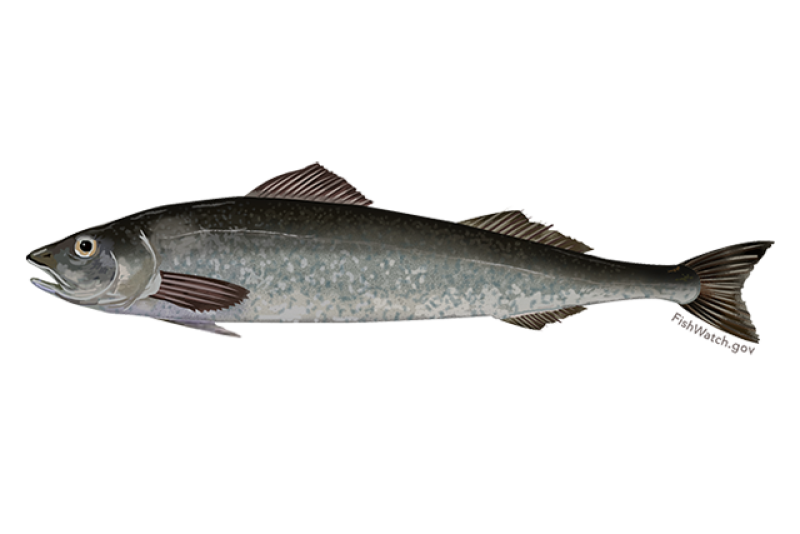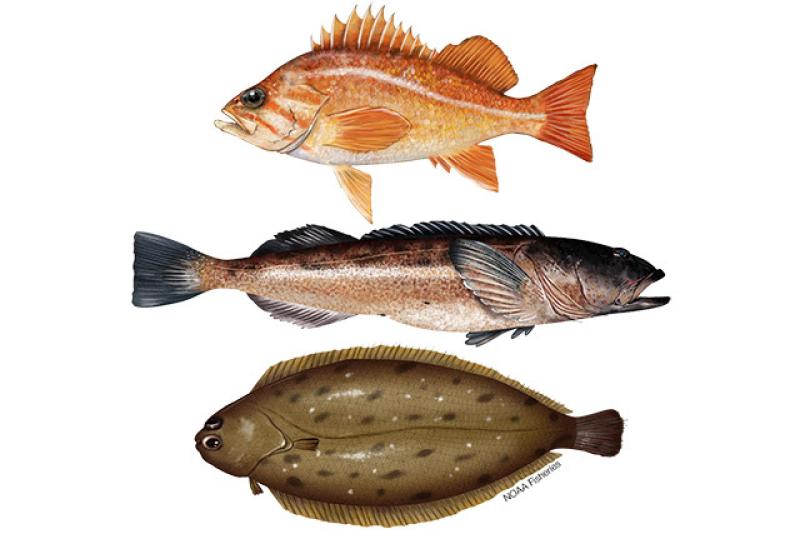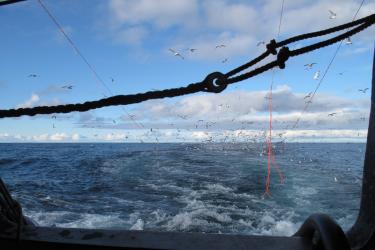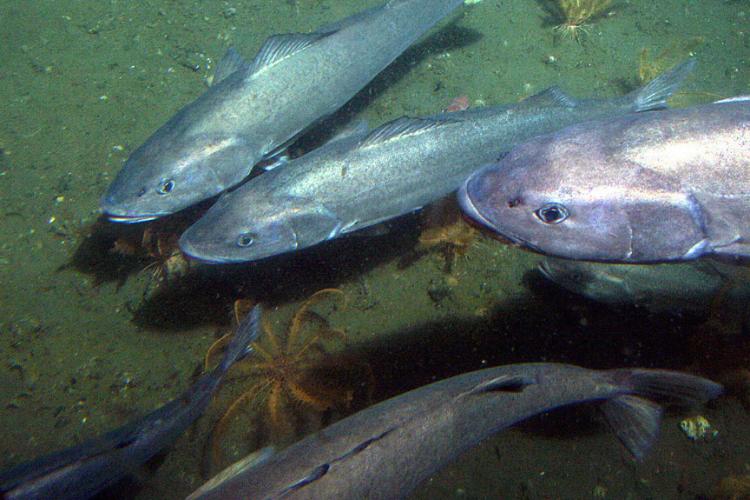
Sablefish swimming just above the sea floor. Credit: NOAA's Northwest Fisheries Science Center
About the Species

Sablefish swimming just above the sea floor. Credit: NOAA's Northwest Fisheries Science Center
Sablefish are a deepwater species native to the Pacific Northwest and Alaska. They are a tasty source of protein, rich in omega-3 fatty acids, and fetch a high price in local markets. Sablefish have been identified as a potential species for commercial farming in the Pacific Northwest, where they are the target of a sustainably managed commercial and recreational fishery. The United States currently does not produce farmed sablefish, but researchers are experimenting with raising them in hopes of creating a viable commercial aquaculture industry.
Appearance
- Sablefish look much like cod. They are often referred to as black cod, even though they are not actually part of the cod family.
Biology
- Females can grow more than 3 feet in length.
- Females are able to reproduce at 6 ½ years old and more than 2 feet in length.
- Males are able to reproduce at age 5 and 1.9 feet in length.
- Sablefish spawn in deeper water along the continental slope from January to April in Alaska waters, and from January to March between California and British Columbia.
- Eggs develop in deep water for about 2 weeks until they hatch, then rise to the surface.
- Hatched larvae are moved by surface currents.
- Off southeast Alaska and British Columbia, juveniles appear in nearshore waters by fall.
- Juveniles have been found to migrate more than 2,000 miles in 6 or 7 years.
- Sablefish can live to be more than 90 years old.
Where They Live
Range
- Sablefish are found in the northeastern Pacific Ocean from northern Mexico to the Gulf of Alaska, westward to the Aleutian Islands and into the Bering Sea.
- There are two populations in the Pacific Ocean:
- Northern population inhabits Alaska and northern British Columbia waters.
- Southern population inhabits southern British Columbia, Washington, Oregon, and California waters.
- Both populations mix off southwest Vancouver Island and northwest Washington.
- They are most commonly found in Alaska waters.
Habitat
- Adults live on mud bottoms in waters deeper than 650 feet.
- Juveniles live throughout the water column in nearshore waters.
Scientific Classification
- Sablefish are found in the northeastern Pacific Ocean from northern Mexico to the Gulf of Alaska, westward to the Aleutian Islands and into the Bering Sea.
- There are two populations in the Pacific Ocean:
- Northern population inhabits Alaska and northern British Columbia waters.
- Southern population inhabits southern British Columbia, Washington, Oregon, and California waters.
- Both populations mix off southwest Vancouver Island and northwest Washington.
- They are most commonly found in Alaska waters.
- Adults live on mud bottoms in waters deeper than 650 feet.
- Juveniles live throughout the water column in nearshore waters.
Scientific Classification
| Kingdom | Animalia | Phylum | Chordata | Class | Actinopterygii | Order | Scorpaeniformes | Family | Anoplopomatidae | Genus | Anoplopoma | Species | fimbria |
|---|
Last updated by NOAA Fisheries on 06/23/2025
Featured News
 A new ocean model developed by NOAA researchers could help us to more effectively manage critically important species along the West Coast and in Alaska, like snow crab. Credit: iStock
A new ocean model developed by NOAA researchers could help us to more effectively manage critically important species along the West Coast and in Alaska, like snow crab. Credit: iStock
NOAA Launches New Ocean Modeling System for West Coast and Alaska
 Celebrate Culinary Arts Month with a sustainable seafood recipe for every month of the year.
Celebrate Culinary Arts Month with a sustainable seafood recipe for every month of the year.
What Your Birth Month Says About Your Next Seafood Recipe
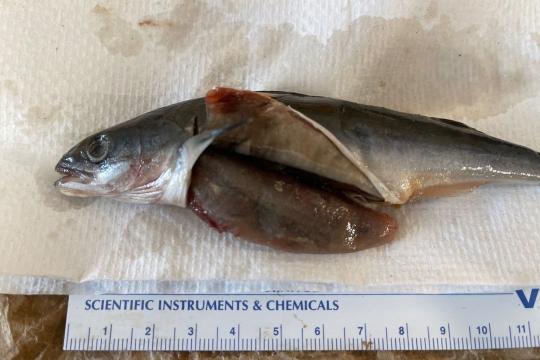 Scientists examined the stomach contents of juvenile sablefish in coastal waters, finding evidence of their voracious appetite including other fish almost as big as they are. Photo by Elizabeth Daly/CIMERS.
Scientists examined the stomach contents of juvenile sablefish in coastal waters, finding evidence of their voracious appetite including other fish almost as big as they are. Photo by Elizabeth Daly/CIMERS.
Young Salmon May Face Hungry New Competition from Juvenile Sablefish along Northwest Coast
 Chef Tyler Hadfield’s Curried Skate Wings with Tomato-Masala Chutney
Chef Tyler Hadfield’s Curried Skate Wings with Tomato-Masala Chutney
Ring In the New Year With These Crowd-Favorite Seafood Recipes
Seafood Facts

Is Sablefish Sustainable?
U.S. wild-caught sablefish is a smart seafood choice because it is sustainably managed and responsibly harvested under U.S. regulations.
Availability
Year-round.
Source
Wild-caught off Alaska, Washington, Oregon, and California. U.S.-farmed sablefish is not currently available commercially.
Taste
Sablefish have high oil content, making them exceptionally flavorful. They are often called butterfish because of their melt-in-your-mouth, oil-rich meat.
Texture
Soft, velvety texture. Their meat has large, white flakes.
Health Benefits
Very high in long-chain omega-3 fatty acids, EPA, and DHA.
Nutrition Facts
Servings: 1; Serving Weight: 100 g (raw); Calories: 195; Protein: 13.41 g; Total Fat: 15.3 g; Total Saturated Fatty Acids: 3.201 g; Carbohydrate: 0 g; Total Sugars: 0 g; Total Dietary Fiber: 0 g; Cholesterol: 49 mg; Selenium: 36.5 mcg; Sodium: 56 mgMore Information
Sablefish Recipes
Looking for some ways to add sablefish into your rotation? If you need cooking inspiration, browse these recipes for miso sablefish power bowls, sautéed sablefish, and more!

Last updated by NOAA Fisheries on 06/23/2025
Seafood News
 Photo credits: Tampa Bay Watch (top left); South Carolina Aquarium (top right); North Carolina Oyster Trail (bottom left); Tagal Oceanic/Lisa Tagal (bottom right)
Photo credits: Tampa Bay Watch (top left); South Carolina Aquarium (top right); North Carolina Oyster Trail (bottom left); Tagal Oceanic/Lisa Tagal (bottom right)
A Little Goes a Long Way: How Small Programs Are Educating Communities About Farmed Seafood
 Credit: NOAA Fisheries and Partners
Credit: NOAA Fisheries and Partners
Part 2: Seafood Tips from the People Bringing You America's Seafood
 Commercial fishing boats lined up in Sitka, Alaska. Credit: Shutterstock.
Commercial fishing boats lined up in Sitka, Alaska. Credit: Shutterstock.
NOAA Fisheries Seeks Recommendations for Restoring American Seafood Competitiveness

Celebrate Seafood This Holiday Season
Last updated by NOAA Fisheries on 06/23/2025
Wild-Caught Fishery
Sablefish is one of the highest valued finfish in Alaska and Pacific Northwest commercial fisheries.

Population
The stocks are not overfished.

Fishing Rate
Not subject to overfishing.

Habitat Impacts
The trawl, longline, and pot gear used to harvest sablefish have minimal or temporary effects on habitat.

Bycatch
Regulations limit the amount of incidentally caught and discarded fish in the Alaska fishery. The catch shares program on the West Coast creates incentives to reduce bycatch.
Population Status
There are two stocks of sablefish: Eastern Bering Sea/Aleutian Islands/Gulf of Alaska and Pacific coast. According to the most recent stock assessments:
- The Eastern Bering Sea/Aleutian Islands/Gulf of Alaska stock is not overfished (2023 stock assessment) and not subject to overfishing based on 2023 catch data. Summary stock assessment information can be found on Stock SMART.
- The Pacific coast stock is not overfished (2023 stock assessment) and not subject to overfishing based on 2022 catch data. Summary stock assessment information can be found on Stock SMART.
Fishery Management
- NOAA Fisheries and the North Pacific Fishery Management Council manage the sablefish fishery in Alaska.
- Managed under the Gulf of Alaska and Bering Sea/Aleutian Islands Groundfish Fishery Management Plans:
- Fishing season runs from approximately March 1 to November 15 (subject to change each year).
- Fixed gear (longlines and pots) harvests 90 percent of annual quota and trawl gear harvests about 10 percent.
- The majority of fixed gear is managed with an individual fishing quota (catch shares) program.
- The State of Alaska manages fisheries in state waters under a shared quota system and also manages separate state fisheries.
- NOAA Fisheries and the Pacific Fishery Management Council manage the sablefish fishery on the West Coast.
- Managed under the Pacific Coast Groundfish Fishery Management Plan:
- Coast-wide catch limits among different fishing groups and gear types.
- Daily trip limits for some vessels.
- Individual fishing quota (catch shares) for the trawl fishery and some of the fixed gear fishery. The West Coast groundfish trawl fishery is managed under a trawl rationalization catch share program.
- Full observer coverage in the trawl fishery, partial coverage in the fixed gear fishery.
Harvest
- Commercial fishery:
- In 2023, commercial landings of sablefish totaled 67 million pounds and were valued at $113 million, according to the NOAA Fisheries commercial fishing landings database.
- Sablefish are the highest valued finfish per pound in Alaska and West Coast commercial fisheries because of their rich oil content.
- Gear, habitat impacts, and bycatch:
- Longlines are used to harvest the majority of sablefish in Alaska.
- Increased catch efficiency, because of individual fishing quotas, reduces the number of hooks deployed and effects on bottom habitat.
- Individual fishing quotas reduce bycatch by allowing fishermen to operate at a slower pace and providing incentives to fish efficiently.
- Pot fishing has increased in the Bering Sea and Aleutian Islands, and the Gulf of Alaska, in response to killer whale interactions with fishing.
- West Coast fishermen harvest sablefish with trawls, longlines, and pots.
- Recreational fishery:
- Sablefish are occasionally caught in Alaska recreational fisheries during their summer migrations onto the continental shelf.
Last updated by NOAA Fisheries on 06/23/2025
Aquaculture
U.S. farmed sablefish is a smart seafood choice because it is sustainably managed and responsibly harvested under U.S. regulations.

Environmental Impact
Federal and state regulations and monitoring requirements ensure that sablefish farming (as practiced in the United States) has minimal impact on the environment.
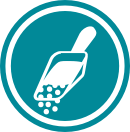
Feeds
Farmed sablefish are incredibly efficient at converting feed to edible protein. Alternative feeds have been developed to reduce reliance on fish meal and fish oil from forage fish.

Farming Methods
Sablefish are spawned and raised in land-based hatcheries until large enough for transfer to net pens.

Human Health
Sablefish are rich in omega-3 fatty acids. Antibiotic use is strictly limited in the United States and is prescribed only on a case-by-case basis by an on-site veterinarian.
Management
- Permitting for sablefish aquaculture is governed by federal, state, and local governments.
- The federal agencies involved are NOAA, the U.S. Army Corps of Engineers, U.S. Fish & Wildlife Service, U.S. Department of Agriculture, the Environmental Protection Agency, the Food and Drug Administration, the Bureau of Ocean Energy Management, and the Coast Guard.
- All fisheries and aquaculture farms in federal waters must adhere to federal regulations including those in the Magnuson-Stevens Fishery Conservation & Management Act, the Endangered Species Act, the National Environmental Policy Act, the Clean Water Act, and the Marine Mammal Protection Act.
Farming Methods
- Hatchery production:
- NOAA’s Manchester Research Station, in partnership with the Jamestown S’Klallam Tribe and others, is experimentally growing juvenile sablefish.
- Sablefish can be difficult to grow because it lives deep in the ocean and faces challenges like the high cost and duration of larval rearing.
- Hatcheries can use captive or wild broodstock.
- Eggs are fertilized externally and then are transferred to environmentally controlled tanks.
- After hatching into fry, juvenile sablefish are raised to about 40 grams and then transferred to a grow-out facility.
- Grow-out facilities:
- Farmed sablefish are grown out in land-based tanks or net pens, which are enclosed cages submerged in an aquatic environment.
- Juvenile sablefish are also transferred from Washington to grow-out facilities in Texas and Canada.
- In Texas, experimental grow-out is in an indoor recirculating system on land.
- When harvested, sablefish are between 5 and 7 pounds.
Production
- The United States currently does not produce farmed sablefish commercially. However, with the species popularity and prized taste there is a growing interest in commercial farming.
Environmental Considerations
- Water quality and benthic impacts:
- Impacts to the environment can occur around fish farms when organic nutrients from uneaten food and fish waste exceed the capacity of the ecosystem to assimilate them.
- Potential environmental impacts are largely avoided with proper farm siting, husbandry, management, and modern technologies.
- Modeling interactions of farms and the environment can help guide decisions about siting locations.
- Fish farms in the United States are required to meet waste discharge standards under the Clean Water Act.
- When farms are sited in well-flushed water, nutrient enrichment in the water column is generally not detectable.
- Proper siting in well-flushed erosional sea floors, and practices such as fallowing, control the impact of fish farms on the benthic environment.
- Escapes:
- On rare occasions farmed fish escape and can possibly interact with their wild counterparts.
- Federal and state permits require containment management systems at all marine sites.
- NOAA is using models to understand the risk of escaped fish affecting the genetic diversity of wild populations.
Animal Health
- Management and remedies:
- Fish diseases occur naturally in the wild, but their effects go unnoticed because dead fish quickly become prey.
- Vaccines, probiotics, limiting farming density, high-quality diets, and controlled use of antibiotics prevent bacterial diseases in fish.
- Management of viral infections occurs through thorough monitoring, healthy culture conditions, low stress environments, and good nutrition and genetics.
- Parasites are controlled on farms using therapeutants, fallowing farm sites, and pest management such as the use of cleaner wrasses.
- Most states have comprehensive aquatic animal health regulations, such as routine health exams by veterinarians.
- Antibiotic use:
- In the United States, antibiotics may only be used to treat bacterial infections in marine fish under direction of a veterinarian on a case-by-case basis.
- Antibiotics are considered a method of last resort and cannot be preemptively fed to fish.
- Special permits obtained from the Food & Drug Administration may be required.
- Vaccines have been effective in reducing, and in some cases eliminating, the need for antibiotics.
Human Health
- Contaminants:
- Aquaculture feed is regulated and monitored by the FDA and state agencies to ensure feeds are not contaminated with heavy metals or methyl mercury.
- Both wild and farmed seafood contain low levels of polychlorinated biphenyls (PCBs).
- PCB levels in farmed sablefish are orders of magnitude below the FDA lower limit.
- Health benefits:
- Like wild sablefish, farmed sablefish contain high levels of omega-3 fatty acids.
Last updated by NOAA Fisheries on 06/23/2025
Science Overview
NOAA Fisheries conducts various research activities on the biology, behavior, and population health of sablefish. The results of this research are used to inform management decisions for this species. For detailed information about stock status, management, assessments, and resource trends, you can search for sablefish, and any other species of interest, using NOAA’s StockSMART web tool.
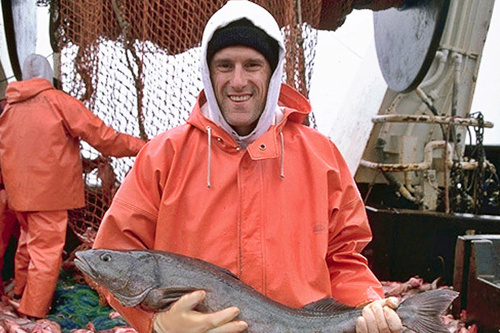
Sablefish Research in Alaska
Scientists at NOAA’s Alaska Fisheries Science Center and Northwest Fisheries Science Center assess the abundance of sablefish in their region through annual longline surveys and trawl surveys every one to three years. Sablefish data are also collected by fishery observers and through required and voluntary logbook programs.
NOAA Fisheries has been tagging and releasing sablefish in Alaskan waters since 1972. Although the results of longline surveys are the primary data used to determine sablefish quotas, tag data provide complementary information that enhances survey data. For example, using data from the tagging program, scientists have discovered that sablefish are highly migratory and that their migration can affect the amount of fish available for harvest in an area.
Learn more about Sablefish research in Alaska
Researching Farmed Sablefish
Aquaculture Management
NOAA collaborates with a variety of partners to research new and evolving techniques for farming sablefish sustainably. For example, the National Ocean Service’s CASS Program assesses aquaculture environmental interactions and develops spatial planning and eco forecasting tools. NOAA Fisheries and partners also work on the OMEGA Model to assess risk and develop management approaches that address the genetic and ecological effects of escaped fish on wild fish of the same species.
Growth and Reproduction
The Northwest Fisheries Science Center’s Manchester Research Station has been exploring techniques to produce all-female sablefish stocks, which grow significantly faster than males. They have also been developing sablefish larval rearing techniques to reduce the cost and duration of rearing, and studying sablefish genetics to understand how fish grow, resist disease, and mature.
The Southwest Fisheries Science Center has been using genetics and genomics to evaluate broodstock selection and investigate how genetics of reared fish relate to health and fitness.
More Information
- Alaska Sablefish Fisheries and Assessments
- Alaska Sablefish Tagging Program
- Fish Out of Water: How Capture Affects Sablefish Health, Reflexes, and Survival
- Observations of Fine-Scale Juvenile Sablefish Movements Reveal Behavioral Patte…
- Research Findings Lead to a More Optimistic Picture of Sablefish
Recent Science Blogs
Last updated by NOAA Fisheries on 06/23/2025
Documents
Alaska Sablefish Longline Survey Station Schedule
The Alaska Fisheries Science Center's longline survey station calendar.
Black Cod Almanac 2025
A yearly brief summarizing research and population assessments for the Alaska region on Black Cod /…
2023 Alaska Sablefish Longline Survey Report
The primary objectives of this survey were to determine the relative abundance of sablefish and…
2022 Alaska Sablefish Longline Survey Report
The primary objectives of this survey were to determine the relative abundance of sablefish and…
Data & Maps
2024 Gulf Of Alaska Ecosystem Status Report: In Brief
This assessment summarizes and synthesizes climate, biological, and fishing effects on the shelf…
Ecosystem Status Report 2024 Gulf of Alaska
This assessment summarizes and synthesizes climate, biological, and fishing effects on the shelf…
2024 Aleutian Islands Ecosystem Status Report: In Brief
This assessment summarizes and synthesizes historical climate and fishing effects on the shelf and…
Ecosystem Status Report 2024 Aleutian Islands
This assessment summarizes and synthesizes historical climate and fishing effects on the shelf and…
Research
2023 North Pacific Groundfish Stock Assessments
2023 North Pacific Groundfish Stock Assessment and Fishery Evaluation Reports for 2024 Fisheries
2022 North Pacific Groundfish Stock Assessments
2022 North Pacific Groundfish Stock Assessment and Fishery Evaluation Reports for 2023 Fisheries
North Pacific Groundfish Stock Assessments and Fishery Evaluation Reports
Alaska Groundfish Stock Assessments, Economic Status Reports, and Ecosystem Status Reports.
Outreach & Education
2025 Alaska Fisheries Science Center Longline Survey
Research brief for the Alaska Fisheries Science Center Longline Survey.
Alaska Longline Survey Research Brief 2023
This is a flyer that describes the annual Alaska longline survey for sablefish and other groundfish…
Compliance Guide: Sablefish Electronic Fish Tickets
Plain-language summary of changes to to fishing regulations regarding new requirements for…
Last updated by NOAA Fisheries on 06/23/2025
